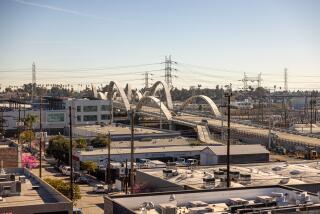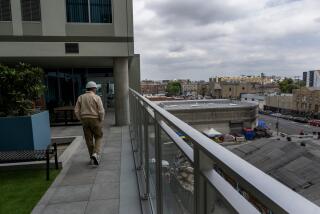Billboard on Wilson Building Obscures Its Landmark Tower
- Share via
In this city, signs are often more important than the structures that hold them up. Take the Wilson Building, for instance. It has been around since 1929 and is located at the northeast corner of La Brea Avenue and Wilshire Boulevard, but few people ever notice the building itself. They are more likely to notice its Asahi Beer sign, which can be seen for miles around. People now refer to the building as the Asahi Building.
It used to be that everybody knew it as the Mutual of Omaha Building, because a huge advertisement for that company obscured the top of this crenelated tower. This 150-foot building is nothing more than scaffolding for a sign.
But if you look behind--or rather below--that rather obtrusive bit of neon, you’ll find a very decent building. It was designed by the firm of Meyer & Holder, who also gave us Grauman’s Chinese and the Egyptian Theatre in Hollywood. This structure is not nearly as exuberant or exotic as those, but it is also more than just an office building. It is above all else a tower, a marker that holds the corner where two thoroughfares meet. That tower steps up to its full 11 floors with an ordered rhythm of setbacks whose cadences adjust themselves to the slight irregularity of the lot. Finally, a slender, square top emerges, its finials blending into buttresses that fly up to the mechanical space that crowns the whole effort. When the tower was constructed, a dirigible mast transformed the last decorative flourishes into a single exclamation point.
The strange thing about this upward rush of steel and stone is that it is completely disconnected from the street. The first three floors of the building are an irregularly shaped volume, rounded at the corner, that completely fills out the lot. The tower sits so far back from this base and has so little relationship in its geometries to the curved rhythms of what were once glass store windows that you would think it is just hovering three stories above the ground. The only thing that ties the two pieces together is the rather plain skin (or what remains of it after countless renovations, which, as far as the base goes, is not much) and a few decorative flourishes. Even the lobby, which you assume would introduce you to the tower, is just a narrow little slot that the architects fitted into the Wilshire Boulevard frontage.
The Wilson Building was designed to do two things: to stand out in the landscape and to provide seductive shop frontage on the street. The latter function has been utterly destroyed by the renovations that have layered ugly shop fronts over the once-elegant ribs of the building. The tower is still there, but nobody notices it. For the last several decades, though, the building has had a third function, namely that of billboard structure, and you might say this latter function has completely usurped the other two.
*
Many might argue that, in the process, the landmark status of the building has been destroyed because its graceful top is hidden by the commercial corset that hovers around the crown. Yet the new sign has a strange beauty about it, especially at night, when you can see its simple message and red, blue and white colors.
It might be nice, of course, if the building’s owners were to replace the current box with a lighter, more expressive sign that continued, rather than drowning, the upward thrust of the tower, but it would also have been nice if the original architects had created a tower that was more connected to its commercial base. The Wilson Building was never a piece of great architecture, but it was always an exciting part of our urban landscape, and it has transformed itself along with that environment into a collage of composed and commercialized moments.
* Wilson Building: northeast corner of Wilshire Boulevard and La Brea Avenue
* Architect: Firm of Meyer & Holder
More to Read
Sign up for Essential California
The most important California stories and recommendations in your inbox every morning.
You may occasionally receive promotional content from the Los Angeles Times.






